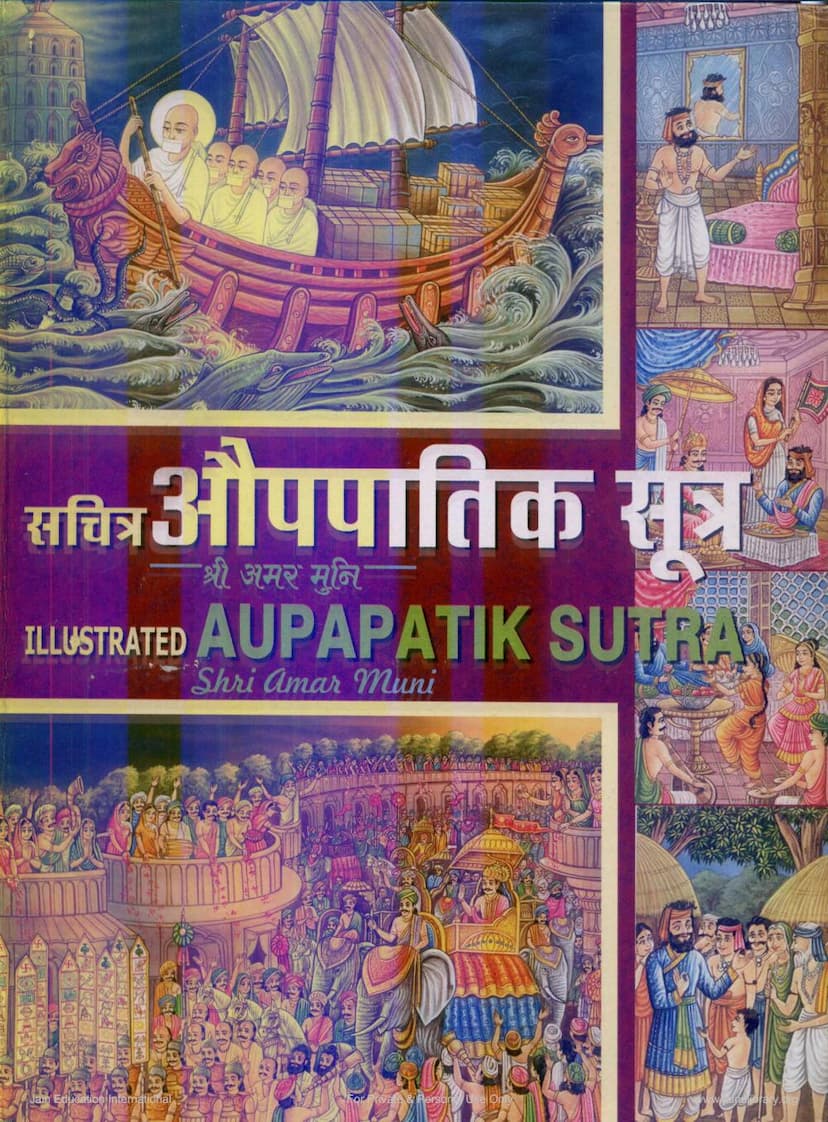Agam 12 Upang 01 Aupapatik Sutra Sthanakvasi
Added to library: September 1, 2025

Summary
Here's a comprehensive summary of the provided Jain text, "Agam 12 Upang 01 Aupapatik Sutra Sthanakvasi," based on the provided pages:
Overall Purpose and Significance:
The "Aupapatik Sutra" is the first Upanga (auxiliary text) in Jain Agamic literature, attributed to accomplished senior ascetics. It holds a special place in Indian literature, not only for its spiritual and philosophical insights but also for understanding ancient Indian society, culture, religious traditions, and philosophical currents. The Agam aims to answer profound questions about reincarnation, explaining how certain conduct and actions lead to rebirth in specific realms or places.
Core Meaning of "Upapat":
"Upapat" refers to the reincarnation of a soul. The Sutra addresses the fundamental question: "What conduct and action leads to reincarnation at which specific genus or place?" It provides answers and explanations for these complex queries about rebirth.
Key Features and Contents:
-
Detailed Descriptions: The Sutra offers a rich and detailed portrayal of various aspects of life during the period of Bhagavan Mahavir. This includes:
- Champa City: An elaborate description of the grandeur of Champa, its means of entertainment, its security arrangements (fortifications, moats, gates), its gardens, tree-lined avenues, and the Purnabhadra Chaitya (a Yaksha temple complex).
- King Kunik: A detailed account of King Kunik of Champa, his character, his grandeur, his court, and his impressive physical attributes. The text highlights his devotion and loyalty to Bhagavan Mahavir.
- Bhagavan Mahavir: A vivid and ornate description of Bhagavan Mahavir's physical beauty, his spiritual grandeur, his entourage of ascetics, and his sermon. The text emphasizes his divine attributes and his supreme role as a Tirthankar.
- The Samavasaran: The first part of the Sutra, "Samavasaran Adhikar," details Bhagavan Mahavir's arrival in Champa, the grand procession of King Kunik and his court, and the presence of various celestial beings.
- The Upapat Section: The second part, "Upapat," focuses on the concept of rebirth. It addresses the nature, character, and conduct of different people and their destinations in future births, answering questions posed by Ganadhar Gautam.
- Austerities (Tapas): The Sutra details various forms of external austerities (Anashan, Avamodarika, Bhikshacharya, Rasa Parityag, Kayaklesh, Pratisamlinata) and internal austerities (Prayashchit, Vinaya, Vaiyavrutya, Svadhyaya, Dhyan, Vyutsarg).
- Parivrajakas (Mendicants): A significant portion of the Sutra provides a detailed historical account of various traditions and sects of Parivrajakas existing during Bhagavan Mahavir's time, their philosophical views, their conduct, and their specific practices. The text highlights their immense influence and their often intricate rules of conduct.
- Ambad Parivrajak: A detailed narrative about Ambad Parivrajak, a mendicant who is presented as a follower of both Vedic and Jain traditions, and his miraculous abilities. The text also discusses his eventual reincarnation as Prince Dridhapratijna and his future role as a Tirthankar.
- Causes of Rebirth: The Sutra explains the causes for rebirth in different realms: hellish beings (naraki) due to violence, greed, and unrighteousness; animals due to deception and untruthfulness; humans due to goodness, humility, compassion, and absence of jealousy; and divine beings due to partial observance of vows, voluntary suffering, or even ill-informed austerities.
- Siddhas (Perfected Souls): The text describes the nature of Siddhas, their abode at the "Siddha Shila" (Ishatpragbhara Prithvi), their formless existence, their infinite and unparalleled bliss, and their eternal state beyond birth, death, and suffering.
-
Style of Description: The Sutra is renowned for its unique and exceptional style of description. It provides realistic and comprehensive accounts of its subjects, employing numerous metaphors and rich linguistic beauty. This has led even other major Agamas to refer to its descriptive style.
-
Commentary and Translation: The presented edition features original text with Hindi and English translations, elaborate commentary, and colorful illustrations, making it accessible to a wider audience. The commentary is by Up-pravartak Shri Amar Muni, and the English translation is by Surendra Bothara.
Educational and Spiritual Value:
The "Aupapatik Sutra," through its detailed narratives and profound philosophical discussions, serves as an invaluable resource for understanding Jainism's core tenets, ethical principles, and historical context. It aims to guide individuals towards a life of reverence, devotion, and adherence to lofty ideals, ultimately leading to spiritual liberation. The inclusion of illustrations and translations enhances its value as an educational tool, making complex spiritual concepts understandable and engaging.